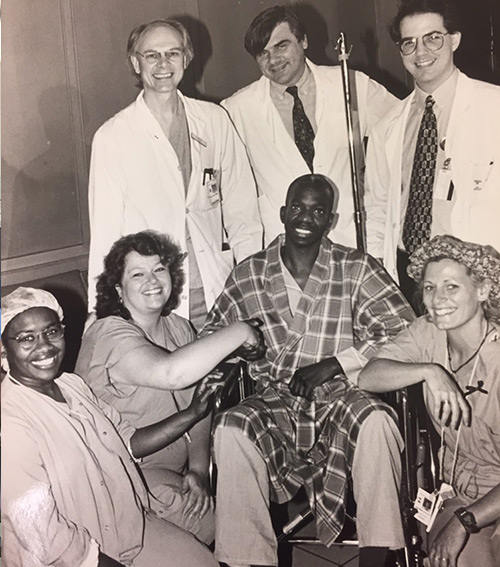The Ajmera Transplant Centre’s Living Donor Liver Transplant (LDLT) Program has performed its landmark 1,000th transplant since the program began in 2000. Dr. Mark Cattral – who assisted in the first LDLT at UHN in 1996 – performed the milestone surgery this month. Dr. Cattral is the Surgical Director of the LDLT Program at the Ajmera Transplant Centre and a surgeon in the Sprott Department of Surgery.
While patient privacy prevents sharing specific details, both the donor and recipient are recovering well.
In Canada, most liver donations are from deceased donors. But the reverse occurs in many Asian countries, including Japan, where the vast majority of liver transplants are made possible by living donors.
With disproportionately low rates of deceased organ donation, Japan was quick to standardize LDLT after the first successful surgery in 1989. Since long-term outcomes for donors were yet to be fully studied, LDLT was initially limited to pediatric transplant recipients.

In 1996, Dr. Cattral flew to Kyoto with Dr. Paul Grieg, then Surgical Director of the Liver Transplant Program, to visit the LDLT program at Kyoto University Hospital.
Three days after returning to Toronto, Drs. Cattral and Grieg performed Canada’s first LDLT surgery, permitting a father to save his daughter’s life.
The UHN adult LDLT program was established in April 2000. Living donor transplants started gradually, but with excellent outcomes for both donors and recipients, the pace of living donation at UHN accelerated. Last year alone, the team performed a record 78 surgeries, despite the challenges of COVID-19.
“UHN had the first LDLT program in Canada, and we remain the largest and the most active,” says Dr. Cattral. “We have the most experience in the western world.”
LDLT is the preferred treatment for patients in liver failure; patients are transplanted earlier than deceased donor transplants, in a better state of health, and have better long-term outcomes.
The survival rate for living donors at Toronto General is 100%. After their liver regenerates, donors go back to living normal, healthy lives.
“Now, as compared to when we first started, we are able to offer living-liver donation to most recipients. We have a better understanding of the anatomy of the liver, and as a program, we have a huge repertoire to refer to.”
Anonymous living liver donors
The Ajmera Transplant Centre leads the western world in LDLT, and globally, the program moved into uncharted territory in 2005 with anonymous (or non-directed) living liver donation. These individuals apply to be donors with no intended recipient and leave it to the transplant team to choose the recipient who needs it the most.
The program’s first anonymous donor, Kevin Gosling, donated the left lobe of his liver to a child in 2005. After rigorous assessment and lengthy discussions with the LDLT program, Kevin successfully paved the way for future non-directed donors.
“I remember meeting with the Medical Director of the program at the time,” says Kevin. “And he asked me, why did I want to do this? The best answer I could come up with was ‘because I can.’”
“I think doing something for a complete stranger, especially if it is done anonymously, is a unique opportunity to give someone an entire lifetime.”
“We have the largest world experience with anonymous donors,” explains Dr. Cattral. “We had 16 anonymous donors last year, which is a record-breaking number. In total, we’ve done nearly 100 – and I think that speaks to the fact that Canadians are, by nature, very generous people.”
Since Kevin’s donation, non-directed donors have become familiar to the program, albeit rare. In terms of assessment however, not much has changed since 2005.
“We’ve always put the donor’s safety first and foremost. We purposely have redundant processes in place to make sure we don’t miss anything,” says Dr. Cattral. “There’s redundancy in every step of the way.”
Just ‘playing our part’
Despite the recurrent processes that keep donors safe, the difference between the first and one thousandth is, for Dr. Cattral, nonexistent.
“Since we started the program in 2000, surgery on donors feels exactly the same to me as when we first started.”
“For every donor, it’s like we’re doing it for the first time. We don’t lose sight of the fact that what we’re doing is extraordinary. Living donors don’t need surgery, they aren’t sick, and that brings a heightened sense of awareness. Surgery on living donors has a different feel to it.”
“What we do requires the effort of an incredible team of individuals. It’s always been a group effort. Our nurses and coordinators play a crucial role in keeping us moving. They’re the face of the program, and they play a key role in our success.”
“Transplantation is transformative. It saves people’s lives; it restores them to good health. We’re just part of the process,” says Dr. Cattral humbly. “We allow someone to help someone else.”
The Ajmera Transplant Centre’s Living Donor Liver Transplant (LDLT) Program has performed its landmark 1,000th transplant since the program began in 2000. Dr. Mark Cattral – who assisted in the first LDLT at UHN in 1996 – performed the milestone surgery this month. Dr. Cattral is the Surgical Director of the LDLT Program at the Ajmera Transplant Centre and a surgeon in the Sprott Department of Surgery.


